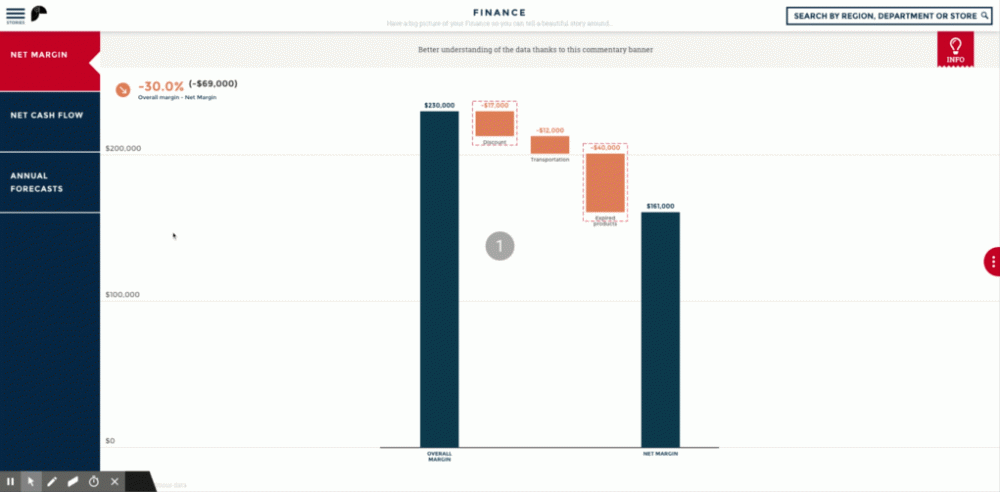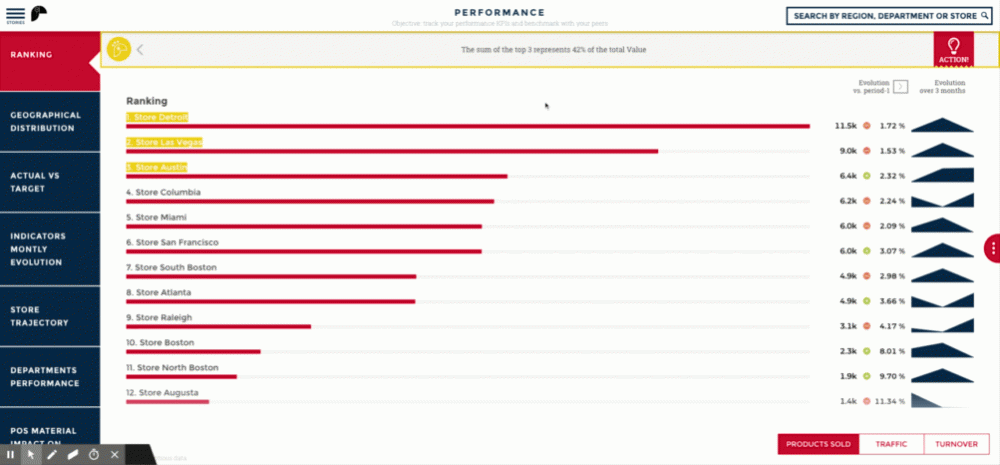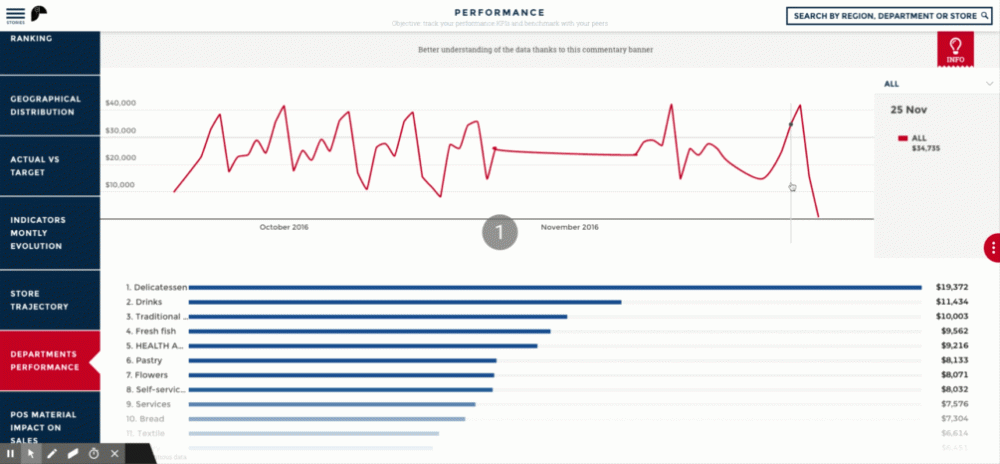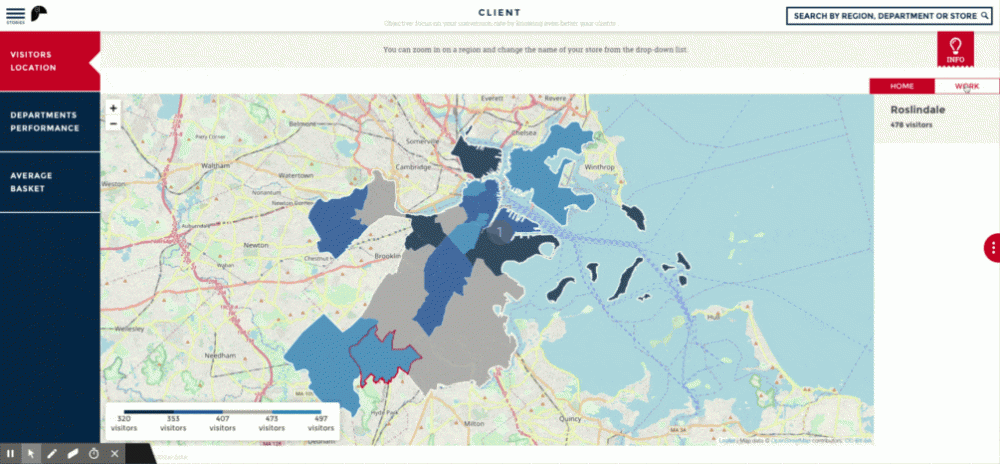
Data storytelling could answer some of the most common pain points facing the retail industry today, equipping every stakeholder to make better decisions, and contribute to a higher bottom line.
Margin compression and the need for data-driven retail
The retail industry is going through a period of flux, with rising traffic offset by shrinking bottom lines. 2012-16 was possibly the best half-decade for retail so far, according to Deloitte, with UK markets growing at 3.1% CAGR. But consider this: sales at physical stores increased by just 1.1% while online saw an uptick of over 19%. On top of that, floor prices in retail have consistently declined, putting the pressure on retailers to make their operations more efficient.
In this dynamic climate, the right data at the right time could make a massive difference. Inevitably, retailers are scrambling to invest in data-driven retail technology, eager to democratize access to insights. But how far has this vision been realized?
Digital transformation in retail remains limited to the C-level
A 2019 study by Deloitte found that at least a quarter of retailers have achieved significant levels of maturity on their digital transformation journey, owing primarily to the role of data. This is because data can help you:
- Understand customer sentiment and boost experiences, at par with e-commerce benchmarks
- Optimize core operations and sales activities to reduce waste
- Discover opportunities for generating revenue, such as untapped markets or new products
On the flip side, access to data-driven retail insights continues to be constrained to a small circle. Over 50% of organizations don’t have the in-house talent needed to analyze datasets, even when they are abundantly available. Bloomberg found that data scientists are now in high demand for physical stores as they look at unearthing value from the reams of data accessible at your typical retail chain.
But it isn’t always possible to station an analytics expert on every floor. And it isn’t advisable to keep the benefits of data-driven retail within a closed circle, at the C-level or those stakeholders conversant in data science. Storytelling bridges this gap between retail data possibilities and on-floor executive requirements.
Data storytelling could answer some of the most common pain points facing the retail industry today, equipping every stakeholder to make better decisions, and contribute to a higher bottom line.
Four challenges in retail and how a Data Storytelling dashboard can help
Gartner reaffirms that data & analytics is a top priority for retail CIOs. It’s vital to ensure that the benefits of data & analytics percolate down to the grassroots levels to enable maximum ROI. Here’s how data storytelling makes this possible.
1. Sync store-specific operations with your C-level strategy
More often than not, organizational objectives are captured in a high-level policy document, followed up by formal training and reviews. Shop executives have little to no visibility on how precisely their performance is meeting these organizational KPIs. This impacts sales and store efficiency until the next review cycle – and by that time, it might be too late.
Storytelling takes ownership of data-driven retail insights away from the sole hands of technical teams. Every employee and manager can view everyday operations, common problem areas, and how a specific factor influences the bottom line.
Take the case of perishable goods: improperly managed perishable goods and food waste can significantly dent your corporate image, not to mention reduce net revenues. It isn’t enough to simply outline a no-waste policy – employees in charge of managing supplies must be aware of how their activities lend to or take away from the bottom line.
A data dashboard that showcases precisely how expired products, discounts required to move perishable goods and the transport of wasted items all together impact profitability.

Data story showing the effect of perishable goods on margins.
You can even enable drill-down for each category, helping personnel target specific issues thanks to a drill-down view of the expired products variable.
2. Share best practices across stores
A big part of data-driven retail is unlocking the same level of performance and profitability across multiple outlets. Success cannot be dependent on individual variables and must be replicated across different locations.
Data storytelling makes the benefits of digital transformation available across the retail chain, highlighting which stores are performing well, key success factors, and negative trends that need to be addressed. Outlets which rank at the top of your performance list should act as inspiration for the entire retail ecosystem.
For example, a country-wide data dashboard can condense complex performance information into an easy-to-read snapshot.

Geographic analysis of performance as per KPIs.
Here, you can see the top-performing stores, the number of products sold, and even a three-month performance overview, using the sparklines on the right. Next, retail employees can analyze the number of products sold via-a-vis in-store traffic – in this dashboard, South Boston ranks #7 in terms of product sales, but #2 in terms of traffic. The dashboard reveals the lack of correlation between sales and traffic.
Clearly, stakeholders at the South Boston locations should conduct knowledge transfers with stores in the top quartile to learn how to convert traffic into revenues. Storytelling makes data-driven retail insights like this accessible even to lay-users.
3. Empower operations managers to make more profitable decisions
Data isn’t just about guiding high-level strategies. It can influence micro-decisions that retailers take every day and incrementally improve store performance. Data storytelling makes it easier to establish this culture of informed decision-making, reducing pressures on the C-suite and encouraging accountability at every step of the value chain.
For example, a store manager could be better positioned to implement a data-driven insight on retail departments. They are more familiar with a site’s requirements and have a better grasp of how myriad operational factors shape performance. A storytelling dashboard compresses data over long periods (weeks or even months) to give a bird’s eye view of department-specific performance.

Month-wise performance for retail departments.
The manager can then select below-average or above-average scenarios to pinpoint which variables made a difference. In other words, data-driven retail insights inspire operational stakeholders to ask the right questions and thereby unlock value-generating answers.
4. Convert customer analysis into genuine action points
In today’s experience-led economy, customer insights are key to sustained profitability and market leadership. Global retail majors like Amazon or Target have set very high benchmarks in customer-centricity, and most retailers are struggling to keep up. Data storytelling lets you capture information from a variety of sources – from in-store surveys to email-based net promoter scores – and extracts valuable ideas.
Let’s look at a highly specific use case: a retailer expanding into a new geography must quickly understand buying patterns in the region, as well as competitor stores appearing in close proximity. Managers can take data from telecom, public records, and third-party sources to understand the exact distribution of customers in that geography.

Customer distribution map of a newly acquired market region.
While this sounds complex on the surface, storytelling condenses what would be multiple spreadsheets, into a visually readable map. And this happens without compromising on granularity – by drilling down into each location, the store manager can reveal further data around their own store.
Why the future of retail will be shaped by data stories
Storytelling places data into the right context, without any need for human intervention or data science expertise. From fresh graduates who joined a store just last week, to non-digital-native operations managers who’ve been at your organization for decades, everyone can draw insights and contribute to your vision of data-driven retail.
Florian Neugue is Retail Specialist at Toucan Toco.


27 t/m 29 oktober 2025Praktische driedaagse workshop met internationaal gerenommeerde trainer Lawrence Corr over het modelleren Datawarehouse / BI systemen op basis van dimensioneel modelleren. De workshop wordt ondersteund met vele oefeningen en pra...
29 en 30 oktober 2025 Deze 2-daagse cursus is ontworpen om dataprofessionals te voorzien van de kennis en praktische vaardigheden die nodig zijn om Knowledge Graphs en Large Language Models (LLM's) te integreren in hun workflows voor datamodel...
3 t/m 5 november 2025Praktische workshop met internationaal gerenommeerde spreker Alec Sharp over het modelleren met Entity-Relationship vanuit business perspectief. De workshop wordt ondersteund met praktijkvoorbeelden en duidelijke, herbruikbare ri...
11 en 12 november 2025 Organisaties hebben behoefte aan data science, selfservice BI, embedded BI, edge analytics en klantgedreven BI. Vaak is het dan ook tijd voor een nieuwe, toekomstbestendige data-architectuur. Dit tweedaagse seminar geeft antwoo...
17 t/m 19 november 2025 De DAMA DMBoK2 beschrijft 11 disciplines van Data Management, waarbij Data Governance centraal staat. De Certified Data Management Professional (CDMP) certificatie biedt een traject voor het inleidende niveau (Associate) tot...
25 en 26 november 2025 Worstelt u met de implementatie van data governance of de afstemming tussen teams? Deze baanbrekende workshop introduceert de Data Governance Sprint - een efficiënte, gestructureerde aanpak om uw initiatieven op het...
26 november 2025 Workshop met BPM-specialist Christian Gijsels over AI-Gedreven Business Analyse met ChatGPT. Kunstmatige Intelligentie, ongetwijfeld een van de meest baanbrekende technologieën tot nu toe, opent nieuwe deuren voor analisten met ...
8 t/m 10 juni 2026Praktische driedaagse workshop met internationaal gerenommeerde spreker Alec Sharp over herkennen, beschrijven en ontwerpen van business processen. De workshop wordt ondersteund met praktijkvoorbeelden en duidelijke, herbruikbare ri...
Deel dit bericht